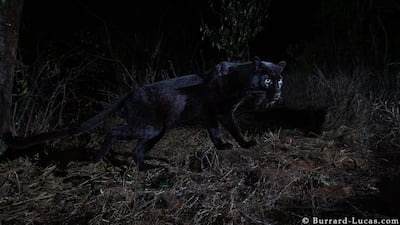The African black leopard is a creature shrouded in legend and mystery. While history has recorded various sightings of the big cat, until now there have been very few photographs published of the animal.
This week, British photographer Will Burrard-Lucas released new pictures showcasing the black panther in amazing detail. The photographer, who was working in collaboration with San Diego Zoo, heard rumours of sightings of the big cat in Nanyuki, Kenya near the Laikipia Wilderness Camp. He decided to set up various camera traps in and around the area. After days of constant monitoring, the camera traps finally captured footage of the animal.
After publishing the pictures on his blog, the story gave rise to news headlines around the world with many outlets including The Independent and National Geographic claiming that this was the first time that the animal had been photographed in 100 years. However, it would appear these claims were exaggerated.
Fake news?
Burrard-Lucas confirmed the headlines were misleading, stating: "I am not claiming that these are the first photos of a black leopard taken in Africa. I do however believe that they are the first high-quality camera trap photographs. The headline, "first in 100 years," appears to have been derived from the following quote published by National Geographic: "these photos represent the first scientific documentation of such a creature in Africa in nearly a century".
Most recorded sightings of the melanistic leopard have been in Asia and African black leopards are extremely rare. However, In 2013, a photographer for the Daily Nation reportedly captured a black panther at the Ol Jogi Game Reserve in Laikipia. Another photograph taken in 2007 at the Ol Ari Nyiro Conservancy seemed to depict the black panther. And in 2001, a group of researchers led by ecologist Mordecai Ogada reported trapping a black leopard. It was also the news of local sightings that brought Burrard-Lucas to the area in the first place.
Some people voiced concerns that the sensationalist headlines were a form of media whitewashing with twitter user @aolaooko writing: "It's not news until a white man discovers an epic in Africa. Get some education!"
Rare footage
Despite the media hyperbole, the photographs are fascinating. Very few images of wild black leopards (or black panthers) exist due to the leopards' secretive behaviour, their camouflage ability and the fact that only a very small percentage (approximately 11 per cent) of leopards are black.
These pictures are believed to be the first shots of the creature that contain enough detail for scientists to use as a basis for further study. The pictures were taken with camera traps from Camptrations Ltd, Burrard-Lucas' technology company.
Some Twitter users expressed concerns about the leopard's safety from poachers now that its location had been made public. Burrard-Lucas disputed this stating: “Fortunately trophy hunting is illegal in Kenya. My take is that the benefits of promoting tourism far outweigh the risks and hence I have stated the location. Tourism brings valuable revenue to these places and is often a critical source of funding for conservation efforts.”


